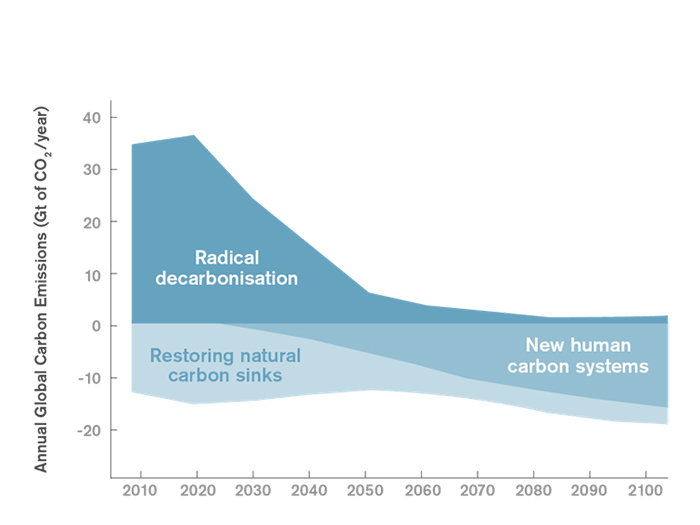The recent IPCC sixth assessment report on climate change states that “rapid and far-reaching transitions across all sectors and systems are necessary to achieve deep and sustained emissions reductions and secure a liveable and sustainable future for all”. Given that the built environment is responsible for 40% of total global emissions, there is now an urgency to reduce not only operational carbon emissions but also the upfront emissions associated with materials and construction of our buildings.

“Most people are familiar with the COP events. COP21, known as the Paris Agreement, is the most significant and led to a new international climate agreement, applicable to all countries, aiming to curtail global warming at 1.5°C above pre-industrial levels,” Aidan Mullen, Sustainability Manager at Interface, says. “The IPCC Reports are basically the findings of a collaboration of scientists who are assessing progress against those original commitments. And their most recent report basically found that we’re in a very serious situation and need to take urgent action to reduce emissions in line with science.”
Science is an important factor which delineates between the lofty 2050 net zero ambitions that countries can put forward and agree to in a conference; and the hard realities of their impact. The IPCC Report stresses the need for nearer term goals, that are science based and aligned with the Paris Agreement. This also puts a responsibility on sustainable businesses to have a closer look at their actions.
“Every company now has to look at their ambitions and say, well, what are we going to do to achieve reductions not in 2050, but in 2030?” says Aidan. “At Interface, 97% of our emissions are within the supply chain. So, to actually maintain alignment with the Paris Agreement, we have to substantially reduce the emissions from our business processes without the use of offsets. And Interface’s Paris commitments – if you want to call them that – are a 50% reduction in remaining Scope One and Scope Two emissions; a 50% reduction in our Scope Three purchased goods and services emissions – so all our raw materials – and even a 30% reduction in our business travel and employee commuting.”
Apart from being great for the environment, this approach makes great business sense. It gets Interface closer to its 2040 goal of being a carbon negative enterprise. Their focus is on decarbonisation through converting to renewable energy, reinventing their products using new, innovative raw materials and further development of their circular economy program, ReEntry.
Life Cycle Assessment (LCA) and the development of Environmental Product Declarations (EPDs) are key to understanding the environmental impacts across a product’s life cycle, which in turn can drive innovation to reduce product carbon impacts, design out waste, achieve circularity, and ultimately have positive climate impacts. Unsurprisingly, Interface has been on the EPD wagon for years already.
“We published the first carpet EPD in North America back in 2009,” says Aidan. “They’re incredibly important because they quantifiably demonstrate the environmental impacts of a product - not just the global warming potential, but other impacts as well. And the great thing about an EPD is it's scientifically modelled to accurately indicate what those impacts are for a product, while being third party verified.”
EPDs offer designers and specifiers an apples-with-apples product comparison so they can confidently make decisions around the carbon footprint of the materials they choose – and in doing so, they’re an important tool in decarbonising the built environment.
So important, in fact, that Interface has an LCA Director in-house to develop the LCAs and EPDs and oversee the process of verification. Aidan notes that due to the proliferation of EPDs for products right across the industry, architects and specifiers can now design with climate (and carbon) in mind right from the outset, rather than looking at ways to minimise impact once a design had been completed as they may have had to do in the past.
“The design fundamentally dictates the carbon footprint of the building,” he says. “And therefore, if you're designing with climate in mind there is a hierarchy for reducing upfront emissions. Firstly, build nothing. Adaptive reuse or refurbishment has much lower carbon impacts. Secondly, build only what is necessary to meet the end user’s requirements.”
Reuse and "less is more" thinking can be a smarter way of constructing your buildings, so that structurally they use less materials, but are just as strong. Interface adopted these techniques when refitting an existing building to be used as its new headquarters. Selection of low carbon materials, reuse and smart design achieved a fifty percent reduction in upfront emissions when compared to the business-as-usual approach.
He notes the focus now needs to be on upfront emissions reductions “as we have the building's operational carbon impacts well under control.”
A great example is the GBCA and NABERS collaborating to develop an aligned method for calculating upfront carbon emissions reductions against a fixed benchmark. The new NABERS building upfront emissions rating tool will be piloted this year and fully launched in 2024.
“The IPCC has drawn a line in the sand, and we shouldn't be daunted by how hard and complicated it is, and not get bogged down waiting for the perfect standard or EPD,” says Aidan. “We need real reductions now. We cannot buy our way to net zero by purchasing carbon credits and call it a day. Architects and designers can lead the way. We have the tools; we just need the collective will to take action.”

